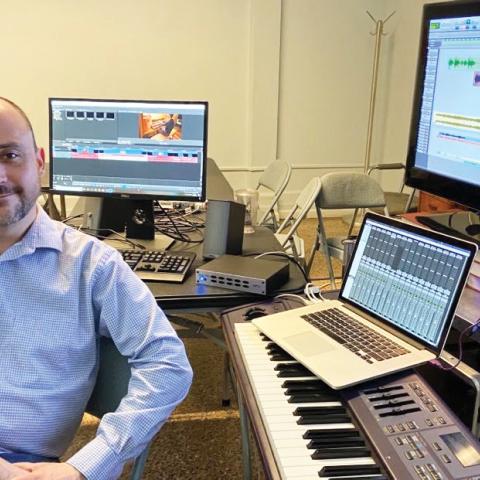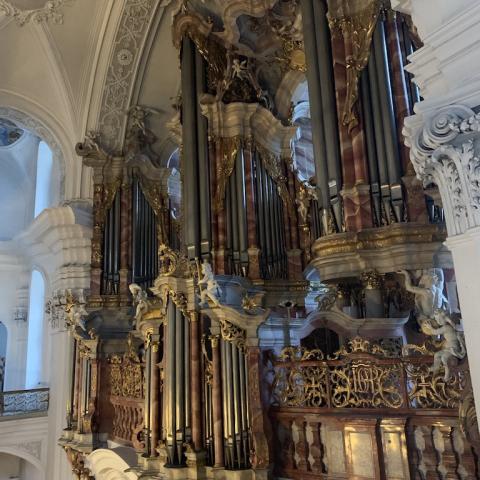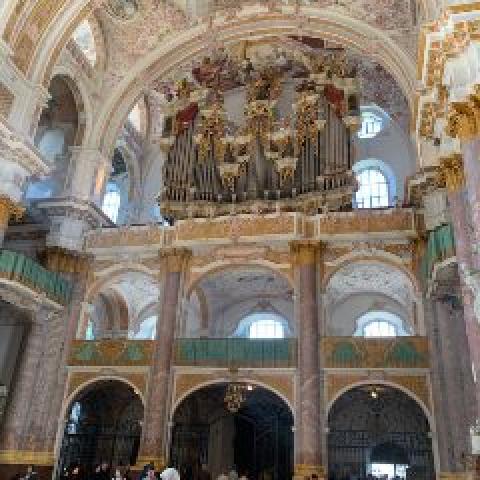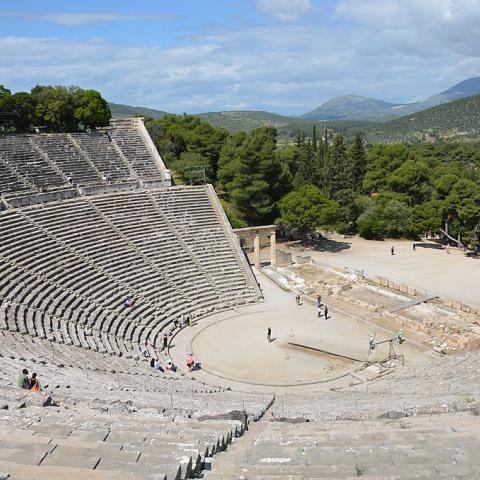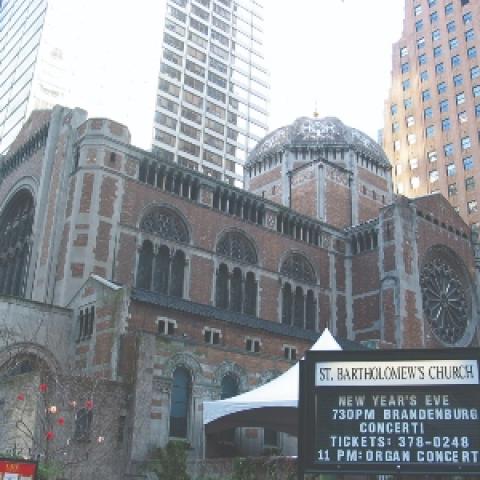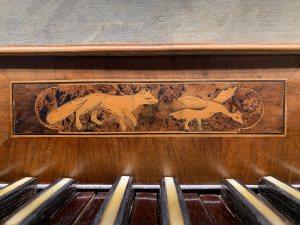
What’s important?
A few weeks ago, I gave a lecture for the organ class at the Eastman School of Music and the Rochester, New York, Chapter of the American Guild of Organists. The following morning, I met with several Eastman students for an informal chat in one of the organ practice rooms on the fourth floor of the school. I wondered what advanced students of the organ are interested in today, what literature excites them, what their dreams and aspirations are, and I was surprised and delighted by the answer from one young man, “Beauty.” What a marvelous outlook from someone embarking on an artistic career.
As a student, I remember aspiring to the next challenging piece, to giving concerts, to holding an exciting church position, but I do not believe I was smart enough to boil the whole effort down so succinctly. I know I loved beautiful music and art, but I wonder if the quest for beauty was at the heart of my ambition? Driving home from Rochester the next day, I reflected on that comment, thinking of all the beauty that the pipe organ has brought to our world, with its vast repertory of music from Jan Pieterszoon Sweelinck and Samuel Scheidt to George Baker and Rachel Laurin, from the ebullient anonymous organs of the fifteenth century to the modern masterpieces of the twenty-first century.
Rural and urban beauty
Where we live in mid-coast Maine, the depth of winter has a rich beauty seen in the foamy salt-water ice and the crackle of snow under your feet when the temperature is below zero. We have walked the six-mile Farm Road in the state park next door on a midwinter midnight, lit by the moon alone, witnessing the noiseless swoop of a snowy owl gathering a vole. We have a transitional season here called “mud season,” when the surface of the lawn and driveway begin to thaw, but deep down everything is still frozen. You go in it up to your ankles, and our half-mile driveway is like pudding, slick and treacherous. When all this melds into spring, the forest comes alive with green, the birds return, the gardens reappear, and the air softens. As I write this, the early morning sun is reflecting off the water illuminating my office, especially magical even at twenty degrees when the wake of an oyster farmer’s boat sets the room in motion. This beauty is mirrored in the mountainscapes of our new home in western Massachusetts with melt-fed streams and rivers rushing toward the sea. In the high summer the rocky coast and active sea have inspired countless artists.
Urban beauty can be mesmerizing, like the countless architectural expressions and decorations of building façades as you walk along lower Broadway in New York City and the majestic sculptures in the city’s parks. There are the Art Deco masterpieces like the Edison and Chrysler buildings on Lexington Avenue, and the fifty-eight-story Gothic Revival Woolworth Building designed by Cass Gilbert and opened in 1913 at 233 Broadway. And then there are the churches. Think of Saint Patrick’s Cathedral and Saint Thomas Church three blocks apart on Fifth Avenue. Across the Avenue from Saint Patrick’s, one finds the Art Deco Atlas with the earth on his shoulders at Rockefeller Center.
In our new home of Stockbridge, Massachusetts, Saint Paul’s Episcopal Church is a building designed by Charles McKim with a statue by Daniel Chester French, baptistry by Stanford White, and windows by John LaFarge and Louis Comfort Tiffany. The little church oozes beauty.
Beauty expressing horror
In the May 2017 issue of The Diapason, pages 16–17, my column was titled, “Music in terrible times.” Wendy and I had just heard the Boston Symphony Orchestra play Dimitri Shostakovich’s Seventh Symphony, nicknamed the Leningrad Symphony, in Carnegie Hall. Germany invaded Russia on June 22, 1941, and began closing off all roads in and out of Leningrad, the last being closed on September 8, isolating and imprisoning three million residents. I wrote:
. . . during the ensuing 872 days nearly a million people died from starvation—one out of three people. Think about your neighborhood. The woman across the street you’ve never spoken to. The kid who delivers your newspaper. The men on the garbage truck. Your husband, your wife, your children. One out of three.
Shostakovich began work on the Leningrad Symphony in September 1941. He and his family were evacuated to Kuibyshev in central Russia that October, and he finished work on the piece there on December 27. The orchestra of the Bolshoi Theatre in Kuibyshev premiered the work on March 5, 1942. The Leningrad Symphony had been evacuated, and there were only fifteen members of the city’s radio orchestra left in town. For the Leningrad premiere, musicians were drawn from the Russian army to fill out the orchestra. I wrote:
If you were a musician serving in the Russian army, you hadn’t practiced in months. Your fingers were rough and stiff from the rigors of military life. Your lips were blistered and raw. You were hungry and malnourished, and your health was sketchy. Maybe there was a morning muster of your unit when the commanding officer barked, “All musicians, one step forward.” What would that mean?
You were released from duty for this special performance and smuggled across the lake to the starving city, where people were trading cats with their neighbors so they didn’t have to eat their own pet. Death was everywhere. Water, electricity, sanitation, and medical care were scarce. Your violin was in a closet, untouched for months, maybe years. You tried to tune it and a string broke. Did you have a spare? If not, too bad, because the shop had been closed since the owner died. Your fingers felt like hammers on the fingerboard, your neck and chin chafed as you tried to play. But you played your heart out.
It is ironic that eighty years after the siege of Leningrad that decimated a great Russian city, the tables are turned, and the Russian army is inflicting the same misery on a neighboring country. We learn nothing from history. How many years of peace have there been during my lifetime?
In that essay, I also wrote about the bombing of Coventry, England, the destruction of that ancient cathedral, and the dedication of the new cathedral for which Benjamin Britten’s War Requiem was commissioned. Britten combined the text of the Latin Requiem Mass with the poetry of Wilfred Owen, commander of a rifle brigade who was killed during World War II at the age of twenty-five.
I opened that issue with this quote from Leonard Bernstein, dating from the days of the Vietnam War:
This will be our response to violence: to make music more intensely, more beautifully, more devotedly than ever before.
Bedazzled by the Baroque
Visiting older organs in Europe, I have been amazed by the level of decoration. During my career as an organbuilder, I have made windchests, keyboards, tower crowns, curved stop jams, impost moldings, all the many components that make up an organ, but every part of every organ I have worked on was made using power tools. Whether I was using a big stationary machine like a table saw or thickness planer or an electric hand tool like a sabre saw, router, or simply a screwdriver, it is still hard work to build an organ. When I stand near a monumental organ built in an earlier time, I think of the incredible labor and dedication it took to mill logs into lumber by human power, to make flat and smooth panels, and to build the elaborate moldings on an impost or tower crown. And as if that was not enough effort, so many of those organs are festooned with statues of lions and angels blowing trumpets, adding to what is necessary to hold up the organ, all for the sake of beauty.
Johann Georg Fux completed the organ for the Fürstenfeld Kloster in Fürstenfeldbruck, Germany, in 1736. Its thirty-five-foot-tall case is a riot of statues, gilded pipe shades, and moldings. Case panels at keyboard level are painted as faux marble. The organ’s thrilling sounds provide a huge dynamic range and variety of tone color. The instrument is placed in a second balcony thirty feet or more above the floor of the nave. It took superhuman effort just to get all that material up there. But if all that was not enough, Fux created a nameboard above the top keyboard with a marquetry pun on his name (German for fox) showing a fox stalking a goose. It must have taken him a week or more to create that image using a knife to shape pieces of wood. I marvel at the dedication to beauty behind an instrument like that.
It is fitting that the organ should be so elaborate because it is placed in a high-Baroque masterpiece of a building with explosions of carved, gilded, and painted beauty everywhere you look. Side altars sport carved spiral columns, shaped like the DNA helix. The pulpit bears a dozen carved images depicting biblical scenes, and the vaulted ceilings are covered with frescos. No effort was spared to pack the place with beauty. Christoph Hauser, organist of the Klosterkirche, has a deep appreciation for the majesty of the place, and his improvisations fill the building with the exuberant voice of the organ.
I attended Mass there in autumn 2019, and after the congregants left, Christoph showed me highlights of the building, demonstrated the organ, and allowed me to open case panels so I could admire the work of our ancestors in the craft. Dozens, perhaps hundreds of workers poured their hearts and souls into the creation of that magical place and that awe-inspiring organ. All this happened forty years before the American Revolutionary War, when American architecture was mostly limited to wood frame structures with little or no decoration.
The beauty of creativity
Beauty is central to the world of pipe organ builders. My work brings me the privilege of visiting many organ shops around the country where I witness craftspeople devoted to beauty. A beautiful architectural case takes shape on a CAD drawing. A tonal director sifts through the numbers and math that will define the organ pipes that will be ideal for the acoustics of a room and the needs of a congregation. A woodworker sorts through rough boards, choosing the right grain patterns for the best visual patterns, and mills, cuts, joins, sands, and finishes the structure, case, and decorations of the instrument. A pipe maker melts, casts, scrapes, hammers, and cuts the metal, forming the exact shapes and soldering the seams. The voicer coaxes the tone of the pipes, introducing them to their music.
In 2018, Dobson Pipe Organ Builders completed a magnificent new organ at Saint Thomas Church in New York City. That project included the design and construction of an unusually ornate case on the south side of the chancel. It seems a miracle that the materials, skill, and ambition still exist to create something that beautiful.
In 2013, Taylor & Boody completed a new organ for Grace Church on lower Broadway in New York City. There are two beautiful cases facing each other across the chancel, each of which includes a passageway from altar rail to side aisle allowing congregants to pass through and down a few stairs after receiving communion. A craftsman local to the builders’ workshop in Virginia was commissioned to create black iron railings to help the people down the stairs, stunning touches of beauty, elegant in their simplicity.
La Belle Époche
Ten years ago (or was it more like fifteen?) Wendy and I were in Paris, France. Before the trip, I wrote to a colleague saying I would be in town and wondered if we might meet for lunch. Her reply, “Gillian Weir is playing at Saint Sulpice on Tuesday night. Meet me in the Choir.” Nice invitation. Dame Gillian played
J. S. Bach’s partita, Sei gegrüßet, Jesu gütig, one of my favorites of Bach’s music, and Messiaen’s Messe de la Pentecôte. I sat with her in the Choeur, gazing around in that huge iconic church, listening to a brilliant musician playing that rich music on the spectacular organ, wondering what could be more beautiful? And the punchline? At the end of the concert, my friend said, “In Paris, we don’t play Messiaen on the Left Bank.”
I was recently reminded of the “Intermezzo” from Charles-Marie Widor’s Sixth Symphony, that colorful, jocular dance that is played far less frequently than the grand and virtuosic opening movement of the symphony. It’s been a Class A earworm for me since. What a beautiful piece, and what great fun. There are many photos of Widor showing a range of facial expressions from dour to serene, but I have never seen one that shows the twinkle in the eye or hint of a smile from a humorist capable of such a frolic. Contrast photos of Widor to the many of Camille Saint-Saëns with the humor of his most bubbly piano concertos evident in his face.
Listening to Dame Gillian playing Widor’s organ all those years ago inspired my daydreams of what it must have been like to be in Paris in Widor’s heyday, the Belle Époche. Visual artists like Auguste Rodin, Henri Matisse, and Paul Gaugin were producing works of great beauty, while at the same time, Massenet, Saint-Saëns, Fauré, and Debussy were revolutionizing the musical arts. The organbuilder Aristide Cavaillé-Coll was building musical masterpieces that included technical and mechanical inventions, driving the musicians who played his organs to new worlds. We must always remember that without Cavaillé-Coll’s genius, we would not have the music of Franck, Widor, Tournemire, Vierne, and all who followed them onto those marvelous benches. It would be difficult to identify a time and place where more expressions of beauty were created.
Reading the memoir of Marcel Dupré, Recollections (as translated from the original French), gives a glimpse into what that time was like with lunchtime gatherings that included artists, musicians, and authors all outdoing each other as raconteurs. Dupré wrote of sitting in awe in the presence of Widor and his friend Camille Saint-Saëns. Wouldn’t it be grand to know what they were talking about?
§
We see rich decorations everywhere in beautiful churches. Pulpits, lecterns, pews, windows, and altars are individual works of art. It is a special challenge to add a monumental piece of furniture such as a pipe organ to those surroundings in such a way that the organ enhances and improves the building. When it does, the effect is breathtaking. The whole effect inspires worship, even before the organ blower is turned on. Add to that the rich tones of the organ, beautiful singing from choir and congregation, and the vast repertory of sacred music, and it is easy to understand what that young man in Rochester was getting at.
We train our bodies to do this magical thing, striving to overcome physical limitations so we do not stand in the way of our artistic expression. We learn to understand the most complex of musical instruments. We learn to alter its voice for each circumstance. We learn to train choirs and to choose literature appropriate for each moment so the worship of thousands will be enriched. Musical performance is momentarily bringing to life the creations of other artists recorded by notation in print or the instantaneous creation of musical forms through improvisation. The presence of beauty is so necessary in this tangled and complicated world, necessary to inspire hope, caring, and exultation. I am grateful for this opportunity to reflect on why we do all this. It is worthwhile and worthy of our best.

